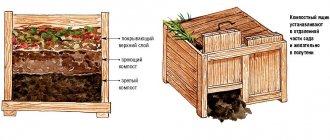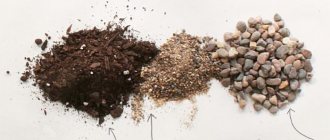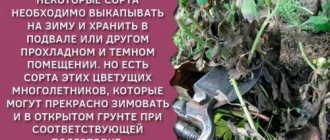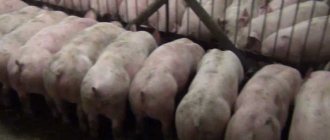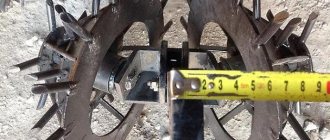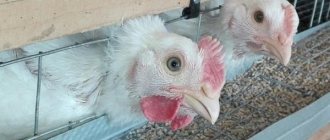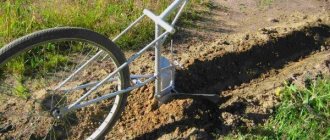What is castration and why is it used?
Usually, only those male piglets that are planned to be kept for breeding are not castrated. It is better to castrate the rest, it is more economically profitable. Such animals grow better and gain weight, do not lose their appetite during heat, that is, weight gain occurs at a constant pace, and after slaughter the meat will not have an unpleasant taste or smell. Pigs do not grow aggressive, they behave calmly, the possibility of accidental unplanned mating of females is excluded when animals of both sexes are kept together.
Castration is also carried out for medical reasons, but not often - in cases of serious diseases of the testes, for example, hernia, inflammation or even a tumor.
The operation of castrating piglets and boars is done to stop the functioning of the gonads. There are several methods - surgical, chemical and radioactive. At home, the surgical method is most often used. Castration of Vietnamese piglets is done according to the same principle as usual; there is no difference between the breeds.
Why is castration necessary?
The essence of the operation is to stop the functioning of the animal’s gonads. To do this, you can forcibly stop the functioning of the organ using special drugs or completely remove the testes from the piglet. In the body of a castrated boar, metabolism slows down and changes in hormonal levels are observed. Therefore, animals that have undergone the procedure are not able to have offspring.
The main reasons why the gonads are removed are:
- Changes in psycho-emotional behavior. Pigs become calmer, episodes of aggression, in which the animal is prone to fights, become very rare.
- Absence of periods of searching for a sexual partner, during which appetite and the amount of food consumed decrease. The individual gains body weight constantly. Rapid weight gain allows you to save on the purchase of feed.
- Improving the taste and weight characteristics of meat.
- Breeding healthy offspring. Not all boars are suitable for fertilizing females. Casual sexual intercourse often leads to malformations of animals and intrauterine death. After the technique, the risk of accidental insemination is reduced to zero.
Castings should not be carried out in conjunction with vaccination of piglets.
The time gap between such procedures must be at least 14 days. Castration is postponed during the period of unfavorable epidemiological situation in the pigsty.
Benefits of castration at an early age
If we compare castration of pigs carried out at an early age and in adulthood, the first option has many advantages:
- Small piglets survive the intervention much easier than adult pigs. Being with the uterus, they quickly calm down and tolerate stress more calmly.
- Mother's milk contains the necessary antibodies, they help heal wounds and preserve the piglets' immunity.
- Boars that are small in weight and size are easier to hold; the operation can be carried out by one person, while a large and strong animal will resist, and this cannot always be handled even with an assistant.
- Castration of a piglet does not necessarily involve the use of anesthesia; wounds heal quickly, bleeding and other complications are rare.
- After hormonal changes that occur at an early age, young animals quickly grow and develop.
- Complications occur less frequently.
It turns out that the sooner the operation is performed, the better.
How much does it cost to castrate animals?
To calculate the cost of castration of one animal, you need to take into account a number of points:
- you should calculate the cost of purchasing surgical instruments. True, they are purchased once and do not require updating for a long time;
- consumables are constantly updated;
- the need to use anesthesia and sleeping pills for the animal should be taken into account;
- The chosen castration method makes an important contribution to costs.
Thus, sterilization of young piglets is much cheaper than the operation of an adult boar. The method of surgical intervention is the most cost-effective compared to the chemical and radioactive method.
Preparing for castration
Animals that are about to be castrated need to be examined and their temperature checked. If there is any suspicion of infection or illness, the procedure will have to be postponed. It is prohibited to castrate a boar if seals or other pathologies are found in the external genitalia. After vaccination or destruction of parasites, at least 2 weeks must pass.
The morning is best for carrying out the procedure, so that during the day you have the opportunity to observe the pigs and provide assistance to them if suddenly needed. The day before the procedure, the piglets stop feeding so that the stomach and intestines are empty. Animal preparation includes washing the scrotal area with warm water and soap and treating it with iodine.
Before starting, the pig is given a local analgesic or not given at all. In the case of processing adult boars, it is impossible to do without an anesthetic, so the drug must be prepared in advance.
Preparatory activities
The first stage is to examine the animal for various diseases, especially infectious etiologies. The scrotal area is examined (cracks, abrasions, scratches, shape, presence of visible bulges or depressions), then body temperature is measured.
The scrotum, including adjacent tissues (up to 5 cm), is washed with ordinary soap, wiped dry, dried in air, then treated with iodine solution or Iodinol. The person performing the castration wears a sterile apron, washes their hands surgically (with plain soap and water), then immerses them in an antiseptic solution (chlorhexidine) and puts on sterile gloves.
Tools
For castration you will need:
Preparation of tools and materials
To castrate piglets with your own hands, first prepare all the necessary tools. For 2-week-old piglets, use combined forceps with a built-in replaceable scalpel and syringes with an anesthetic drug.
For older boars, you need to prepare a scalpel or a sharp blade; tongs will not cut through the skin, which becomes thicker in these animals. You will also need other tools:
- ligature material;
- surgical scissors and needles;
- a surgical clamp used to stop bleeding;
- Zand tongs, they are used for adult boars;
- tampons;
- streptocide or other antiseptics.
Before use, all instruments must be sterilized in boiling water for 0.5 hours or treated with an antiseptic solution. Threads for tying the spermatic cords can be silk, nylon, or you can buy catgut. They also need to be disinfected in chlorhexidine or in a solution of the drug furatsilin.
For convenience, you can use a machine to castrate piglets, but if you don’t have one, you will need the help of another person.
Open way
This method is usually used to castrate piglets under 15 days of age. It consists of the following:
- The animal's testicle is grasped through the skin with the thumb and forefinger of the left hand.
- An incision is made into the scrotal tissue using a scalpel. In this case, the common vaginal membrane is also captured. The cut should be made in one sharp, precise movement. It should run parallel to the suture of the scrotum at a distance of approximately 1 cm from it.
- The exposed testis is removed.
- The transitional ligament is cut off.
- The tissues are carefully moved towards the plow ring.
- With the right hand, the testis is twisted along its long axis and pulled away from the abdominal cavity. In this case, the spermatic cord is fixed through the skin of the neck of the scrotum on the left.
- The cord turns around the index finger and stretches until it breaks completely.
In this way, piglets 10-15 days old are castrated. For animals over 15 days old, the technology for performing the operation should be slightly different. In this case, after cutting the transitional ligament, the tissue is pushed toward the abdominal wall, and the cord is passed between the index and middle fingers. Next, a silk thread is applied to the latter (using a medical knot). The cord is cut at a distance of approximately 1 cm from the dressing towards the testis. In both cases, at the final stage, the wound is treated with a disinfectant.
Methods of castration
Open and closed methods belong to surgical methods. The difference between them: in the 1st case, only the testes are removed, without the vaginal membrane covering them; in the 2nd case, they are cut out along with it. Otherwise, they are similar, so which option the livestock breeder will choose - an open method or a closed one - depends only on his preferences.
There are also bloodless methods - this is chemical castration through the introduction of special drugs. The radiological method is also used, but for obvious reasons, bloodless methods are impossible or difficult to use in households.
Chemical castration
This is a relatively new method that was developed in Australia in 1998. Its essence lies in the fact that the animal is injected with special drugs for at least four weeks. The chemical suppresses the production of testosterone by the testes. Neutered boars have smaller testicles than regular pigs. After the immune castration agent has been given, the boar is kept until slaughter for at least 5 weeks.
The chemical castration agent is called Improvak.
How to properly castrate piglets
Boars older than 6 months are castrated using the closed method, while piglets under six months are castrated using the open method.
Before starting the procedure, you need to wash your hands, treat them with an antiseptic and put on thin rubber gloves. The piglet or boar is placed on its back or side; you can hold the animal upside down. The legs need to be secured with one hand together.
Closed method
The operation is performed in the following sequence:
- Wash the skin of the scrotum and the area adjacent to it with a soap solution (or wipe with a cotton swab soaked in alcohol).
- Make a thin incision on the scrotum, in the direction from the tail down.
- Cut the fascia and the muscular-elastic tunica without affecting the common tunica vaginalis.
- Press down on the scrotum so that the testicle emerges from the incision.
- Apply a ligature to the cord, moving the edges of the scrotum to the inguinal ring and cut it 1 cm from the ligated area.
- Do the same with the second testis.
To help the wound heal better, apply Tricillin or Chemi Spray medicinal aerosol to it.
Open way
This method involves castration “for ligature” and “for breakage”. In the first case, the sequence of the operation is almost the same as in the previous example, with the difference that the vaginal membrane needs to be cut. It is not taken out, but left in place.
Castration of wild boars “on the cliff” is carried out as follows:
- An incision is made on the scrotum along the entire length of the testis, leading it from the tail down.
- The vaginal membrane is also cut.
- The testis is removed, the cord is clamped with a clamp closer to the inguinal canal.
- With the other hand they take the spermatic cord and cut it off with a sharp movement.
After the operation is completed, the wound is treated with an antiseptic.
Chemical method
To stop the activity of the testes and the release of hormonal substances by them, the drug Improvak, developed in Austria in 1998, is used. Injections are given to pigs 2 times with an interval of a month. The minimum age of piglets is 2 months. The drug is administered to adult boars at least 5 weeks before slaughter. 1 bottle of Improvak includes 50 doses of 2 ml.
Closed method
This method is most often used when it is necessary to castrate an adult animal. This method is also necessary in cases where an intravaginal hernia is detected in small piglets. Such an operation should be carried out no earlier than 3 months before slaughter.
Algorithm:
- During this operation, anesthesia is used; adult males are also given sedatives to reduce aggression.
- The male's jaws are tied with a rope so that he does not tear the teeth of the people who are performing the operation.
- If the male lies down during the operation, then he is given general anesthesia, but if the animal remains standing, then local anesthesia is sufficient.
- The skin of the scrotum is cut in two places and the spermatic cords along with the membrane are pulled out through these incisions. Using a tampon, you need to separate the vaginal membrane from the tissues that surround it.
- After this, the spermatic cord must be thoroughly twisted and a ligature applied.
- The testis can then be cut below the thread.
- Next, you need to carefully treat the cut site with an antiseptic and apply a suture.
Methods for restraining piglets during castration.
Caring for piglets after castration
The pigs are placed in a warm and clean pen. Do not put sawdust on the floor; it may get inside the wound. In the first 24 hours, animals are examined to allow time to notice complications after castration. For example, the following may appear:
- bleeding;
- inflammation;
- swelling;
- prolapse of the vaginal membrane, parts of the intestines, and bladder from the incision.
If inflammation or other problems are detected, you must urgently show the animal to a veterinarian; without professional help, you can lose the animal. Most likely, a course of antibiotic treatment will be required.
Pigs should not be fed for the first 24 hours, especially those on which anesthesia was used. Before the wounds heal, they are treated with antiseptic medications; it is convenient to use antibiotic veterinary sprays for this.
Complications
Any operation, even performed as carefully and professionally as possible, can have negative consequences in the form of postoperative complications. This is often due to the individual characteristics of the animal’s body. Complications after castration include:
- Bleeding. If there is intense bleeding at the incision sites, you should contact your veterinarian.
- Organ prolapse. Here, too, you cannot do without the help of a specialist; he will treat the prolapsed organ with disinfectants, set them back and prescribe antibacterial therapy.
- The wounds do not heal for a long time and fester. In this case, it is recommended to treat the surface more often: apply healing ointments and sprinkle the area with antibiotic powders.
- Swelling of the scrotum and prepuce. This is a common postoperative complication. It is important here to prevent an advanced stage. Treatment is mainly carried out with antibiotics; treatment of the swollen surface with ointments and powders is indicated.
- Funiculitis or inflammation of the spermatic cord. Treat with antibiotics or sulfonamides. Sometimes it is necessary to open the wound to remove adhesions.
Peritonitis is the most severe complication. If the disease enters the purulent stage, the animal dies. It is important here to prevent wounds from festering.
Post-operative care
After the operation is completed, the castrated pig requires care and attention from the owner. For the piglet, a room is prepared in advance where the pet will gain strength. The cage is cleaned of dirt, treated with antiseptics and washed using alkali. The floor is lined with fresh straw or hay, but sawdust is not recommended, as this type of flooring increases the risk of complications.
The first days after castration, the piglet feels pain and discomfort, which is why it refuses to eat. You should not force-feed the animal; you should offer it something to eat in the afternoon after surgery. At the same time, they provide easily digestible food.
Castrated piglets and boars are released outside only after the wounds have healed. The owner must daily monitor the condition of the sutures and the well-being of the piglets so as not to miss the development of complications. If there are deviations from the norm, consult a doctor. The following symptoms are considered warning signs:
- the seam does not tighten for a long time;
- severe swelling in the scrotum area;
- redness and suppuration of the wound;
- The animal does not eat for a long time and squeals in pain.
These signs indicate serious complications that will require antibiotics and possibly further surgery.
At what age can the procedure be done?
They try to carry out castration while the piglets are still small, since at this age the process of tissue regeneration proceeds faster. The second reason is that children are more susceptible to anesthesia, therefore, the operation is faster and with the least negative consequences. In addition, suckling piglets next to the sow, along with her milk, receive the antibodies necessary to maintain immunity. Acceptable age for surgery:
- from 3 to 5 days;
- 2 weeks (considered optimal);
- 55 days (weaning time from the sow).
Why are pigs castrated?
Castration is the removal of an animal's reproductive organs and seminal glands. The male retains all the instincts inherent to the species, but is deprived of the ability to reproduce offspring. Let's figure out why the procedure is needed and what its benefits are:
- a castrated male is calm and not prone to aggression;
- the risk of sexual diseases (orchitis, epididymitis) is reduced;
- eliminates the risk of accidental coverage by a bad manufacturer;
- adaptation to living conditions improves;
- despite the decrease in the amount of feed, the animal’s weight gain increases;
- The taste of meat improves, it loses its unpleasant odor and becomes soft.
Important! Castration of an adult animal is possible, but after it the male instinct remains, which makes group keeping difficult. Therefore, it is recommended to perform the operation before 6 months of age.
What is castration and its main goals
Castration of piglets is a procedure as a result of which the gonads stop functioning or are removed. Now there are many methods of quenching: chemical, surgical, radiation and others. Surgery is considered the safest and most common method due to its convenience and low cost.
A male pig that has reached maturity is called a boar, and a castrated pig will be called a hog. The difference between these animals is the ability to have offspring.
After piglets are castrated, their body undergoes important changes: the metabolic rate decreases, the habits and behavior of the pet are transformed.
Purposes of the operation
The main purposes of emasculating piglets at home are:
- Changing the animal's behavior . Mature boars rarely behave quietly. Most males in their prime show aggression, rage and willfulness, so owners resort to sterilization of their pets. A castrated pig becomes calm and peaceful.
- Increase in body weight. After castration, the pig's body undergoes changes, due to which the hog invariably gains weight and gets fat.
- Improving the taste and quality characteristics of meat products.
- Getting healthy offspring. Some boars are not suitable for breeding. To prevent accidental sexual intercourse, farmers emasculate animals, depriving boars of the opportunity to cover sows.
- Saving life. In some cases, castration is not the owner’s desire, but a vital necessity, when castration is performed according to the testimony of a veterinarian.
At what age are piglets castrated?
Many farmers think about what age is best to castrate a piglet. The optimal time for castration of pets is 1–1.5 months of life. This is due to the fact that piglets under two weeks of age are more sensitive to pain than their older counterparts, so surgery is not recommended before this age. In addition, drying should not coincide in time with vaccination of piglets. The interval between vaccinations and castration should be at least two weeks. You should also delay drying if there is an unfavorable epidemiological situation on the farm.
The best time of day for castration is morning, because the owner will be able to monitor the animal’s well-being during the day and will provide assistance to the pet if it is needed.
Benefits of early castration
The advantages of castration up to 1.5 months include the following factors:
- Piglets that have not yet gained much body weight are easier to hold during castration than an adult boar.
- Babies do not require anesthesia, and the intervention takes place with minimal blood loss.
- Piglets endure the postoperative period more easily, and wounds heal faster thanks to the antibodies that animals receive along with their mother’s milk.
- When castrating at a young age, the likelihood of developing complications is lower than when castrating mature boars.
- After surgery, piglets recover more quickly because they are kept with their mother. Adult males are deprived of this opportunity and may suffer psychological trauma.
Required Tools
Castration is a process that involves cutting small blood vessels and soft tissue. You must be prepared for a certain amount of blood to be released from the cut site of the egg.
The tools you need to prepare are:
- Cooper scissors;
- abdominal scalpel;
- stitching and silk threads;
- emasculator;
- needles with a holder, several tweezers (anatomical, surgical and hemostatic);
- catgut.
Technique of the operation
Before you start castrating pigs yourself, you need to understand the basic techniques of the operation.
Closed method
Some farmers who need to castrate a piglet use the closed method. In this case, you will have to squeeze out the piglet’s testicle yourself.
The step-by-step scheme of the procedure is as follows:
- Washing and disinfection of the animal's scrotum.
- Administer local anesthesia so that the pig does not feel pain.
- Cutting the skin on the scrotum. It must be cut very carefully so as not to accidentally damage the vaginal lining.
- Abduction to the side of the testis. Then it is carefully turned and tied with thread at the base.
- Trimming the spermatic cord. It is cut off with scissors at a distance of one and a half centimeters from the bandaging site.
Open way
Experts recommend using the open method when castrating very small piglets. When using this technique, you will have to cut the ligaments, vaginal membranes and scrotum. The procedure is performed as follows:
- The surface of the scrotum is completely cleared of hair and treated with an antiseptic.
- The testis is carefully stretched, after which two identical cuts are made on it.
- The testis is carefully squeezed out through the incised holes and tied with thread.
- The part of the testis above the ligation site is cut off.
- The incision site is treated with powder.
Chemical method
Some farmers do not want to carry out operations at home and therefore prefer to use a chemical method of castration of piglets. This procedure is absolutely painless, as you do not have to cut anything. Experienced farmers advise owners of large farms to use the chemical method. If there are not too many piglets, it is simply not practical to use this technique.
During chemical castration of pigs, a special injection is given. After the procedure, it is necessary to monitor the health of the animals for two weeks to prevent complications from occurring.
See also
Weight of a Vietnamese pig at 6 months and factors influencing weight gainRead
Elastration
People who want to castrate small pigs using the bloodless method can perform elastration. To perform the procedure, special rubberized rings are used, which are strongly compressed during use. This device is gently pulled over the animals' scrotum and squeezed tightly. As a result of this compression, the flow of blood to the testes stops. The procedure must be carried out very carefully.
It is necessary to ensure that during compression the testes descend into the scrotum. After three and a half weeks, the scrotum will atrophy and the rubber rings can be removed.
Castration of young piglets
Manipulation of the removal of the gonads in young piglets of the suckling period is performed by the method of open emasculation. The testes are removed by breaking the spermatic cord.
Homemade castration machine
Progress of operational actions:
- the baby is picked upside down by the hind limbs;
- the operated area is treated with brilliant green or iodine;
- without anesthesia, a careful incision is made in the skin of the scrotum on the left or right;
- the testis is taken into the hand;
- gradually pull the cord using the method of smooth or sharp twisting, breaking or cutting;
- mandatory antiseptic treatment of the damaged area;
- the procedure is repeated with the other testicle;
- place the operated boar in a clean pen with fresh bedding; the use of sawdust is not allowed.
Scheme of castration
Compliance with all sanitary requirements and a week of monitoring the animal will prevent possible abscess or other complications.
Helpful advice
Uncastrated animals are kept on farms quite often. Therefore, some pig breeders are probably interested in the question of what methods can be used to calm wild boars during heat. In this case, experienced farmers simply inject pigs with a one percent aqueous solution of platyphyllin. After injection with this drug, the animals completely calm down. Such injections are given at the base of the ear three times, at intervals of a day. As in the case of surgical castration, the animal is fed only a few hours after the injection.
Of course, a farmer who wants to make his business profitable should know not only how to raise pigs, but also how to castrate. After all, be that as it may, at the moment, when raising piglets for meat, this procedure is necessary. If this is not carried out, the costs of feed and keeping animals will be much higher, and selling the meat itself will become much more difficult.

